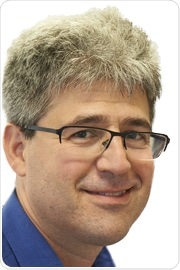An interview with Professor Paul Gissen, conducted by Kate Anderton, BSc
What is childhood dementia, how common is it?
Childhood dementia is a group of conditions which can occur at any time during childhood.
 Credit: Evgeny Atamanenk/Shutterstock.com
Credit: Evgeny Atamanenk/Shutterstock.com
Fortunately, it is not very common. If you take each individual disorder, the frequency could be between one in twenty thousand people in the population, to one in a million in the population. But if you take the whole group, then the prevalence will probably be one in 10 thousand or even more frequent than that.
What causes childhood dementia? Are the symptoms similar to adult dementia?
Many gene defects have been linked to childhood dementia. Often, these genetic abnormalities are the same ones that cause dementia in adults, but the more severe forms are linked to childhood dementia. The mutations can either be sporadic, autosomal dominant or autosomal recessive, meaning the child can either inherit the mutation from one or both parents, or neither.
Childhood dementia is mostly caused by single gene defects. One example is CLN2 type Batten disease which is a disorder caused by a mutation in the gene that affects the function of lysosomes. These are cellular organelles that are involved in the recycling of proteins, fats and other materials.
Defects in lysosomal function can lead to an accumulation of molecules in the cell, ultimately resulting in cell death. Childhood dementia can also be caused by primary defects affecting other organelles in the cell, such as, for example, peroxisomes.
In most cases, the symptoms are identical to dementia in adults. Patients may develop completely normally from birth, and show no signs of the disease for the first few years of life. However, at some point, they start losing the skills required for development.
To start with, children may appear more clumsy than usual and certain movements become more difficult. Over time, they lose their ability to walk independently and become completely reliant on their parents for support.
Slowly, the child begins to lose their ability to communicate, and their speech becomes more and more difficult to understand. They struggle to learn new words compared to their peers, and slowly stop being able to form sentences. After that, only occasional words or occasional syllables that can be heard.
Children with dementia also lose the ability to retain information. They struggle to remember things in the near past and of course, when you lose the ability to remember things, learning becomes extremely difficult.
In some types of childhood dementia, such as CLN2, children can also lose their vision. This is a gradual process that, after many years, causes them to go blind. In other forms of dementia, such as Niemann Pick type C disease, children may lose their ability to hear.
Living with Childhood Dementia: Kaycee's family story
How is childhood dementia diagnosed, what is the typical age of onset?
As I said, there are various conditions that can cause childhood dementia. In a specific example, patients with CLN2 disease (a type of Batten Disease) typically show a normal developmental profile until they are about the age of three. After that, they suddenly begin to lose their speech, and start having epileptic seizures. They become clumsy, and then slowly start losing their vision.
Often, the first seizure occurs around the age of three, and by four and a half years old, most children with this condition are unable to walk. By the age of about six, their vision will be significantly impaired and sadly, most children will die by the age of 10 years old.
As childhood dementia encompasses a group of conditions, it is difficult to diagnose using one test. Some of the conditions can be diagnosed quite simply by sending a blood test to the laboratory, and testing for a specific enzyme function. For example, CLN2 type Batten Disease is caused by a lack of an enzyme called TPP1, function of which can be assayed in the blood of the patient.
The problem with diagnosing childhood dementia early is that the initial symptoms are non-specific, so they’re often not considered important. These diseases are rare and most of the general practitioners and even general pediatricians, don't see these conditions very frequently. They will have seen maybe one case in their working life, sometimes none, and if they don't think about these conditions, they may not order specific tests to diagnose them.
Why is it important to raise awareness of childhood dementia?
It’s important to raise awareness of childhood dementia in the medical community so that physicians start to recognize that a child who is presenting with clumsiness after developing completely normally for the first few years of life, or whose speech is deteriorating, may have one of the forms of childhood dementia. Children may be labelled as “lazy”, instead of being investigated for the condition.
Just knowing the diagnosis makes a huge difference, because then the parents don't have to go for continuous testing and assessments. In addition, being able to say to the school and everyone else that their child has a specific condition that will require counseling and extra help, is extremely important.
There are also therapies that are being developed, and some that are already available, that can help with the symptoms or even prevent deterioration. Having the diagnosis enables children to be enrolled onto clinical research trials and have access to these novel therapies.
Living with Childhood Dementia: George's Story
What are the aims of the ‘Dementia Strikes Children Too’ campaign?
The Dementia Strikes Children Too campaign was set up to raise awareness of childhood dementia among physicians and parents. We wanted to make it known that these conditions, although rare individually, are not so rare when they're taken as a group and that they must be diagnosed.
At the moment, children can wait up to 10 years for a diagnosis. Being able to reduce this delay was incredibly important to us. These are devastating conditions. Imagine that your child has been developing normally and then suddenly they begin to lose all their skills and die early, sometimes in pain. If we can prevent that as well by developing novel treatments, that's a big deal.
Even without the new treatments coming in, the support that can be provided now is quite important. Both psychologically as well as medically.
Where can readers find out more information?
About Professor Paul Gissen
 Paul Gissen is the Head of “Genetics and Genomic Medicine” academic programme at the UCL GOS Institute of Child Health and Honorary Consultant in Paediatric Metabolic Diseases at Great Ormond Street Hospital.
Paul Gissen is the Head of “Genetics and Genomic Medicine” academic programme at the UCL GOS Institute of Child Health and Honorary Consultant in Paediatric Metabolic Diseases at Great Ormond Street Hospital.
In 1995, Paul graduated with a medical degree with commendation from the University of Glasgow. He went on to complete paediatrics training at Manchester, Sheffield and Birmingham Children’s hospitals with specialization in Inherited Metabolic Disorders.
Paul completed a PhD at Birmingham University, where he studied the genetics of rare paediatric metabolic disorders and became interested in molecular and cellular basis of intracellular trafficking disorders.
Paul moved his lab to UCL MRC Laboratory for Molecular and Cell Biology in 2011 and has continued to carry out research at the Great Ormond Street Hospital for Children. His current research focuses on development of novel therapies for children with inherited metabolic disorders.